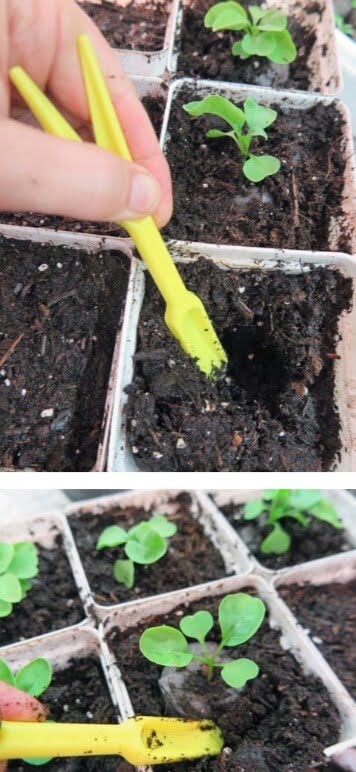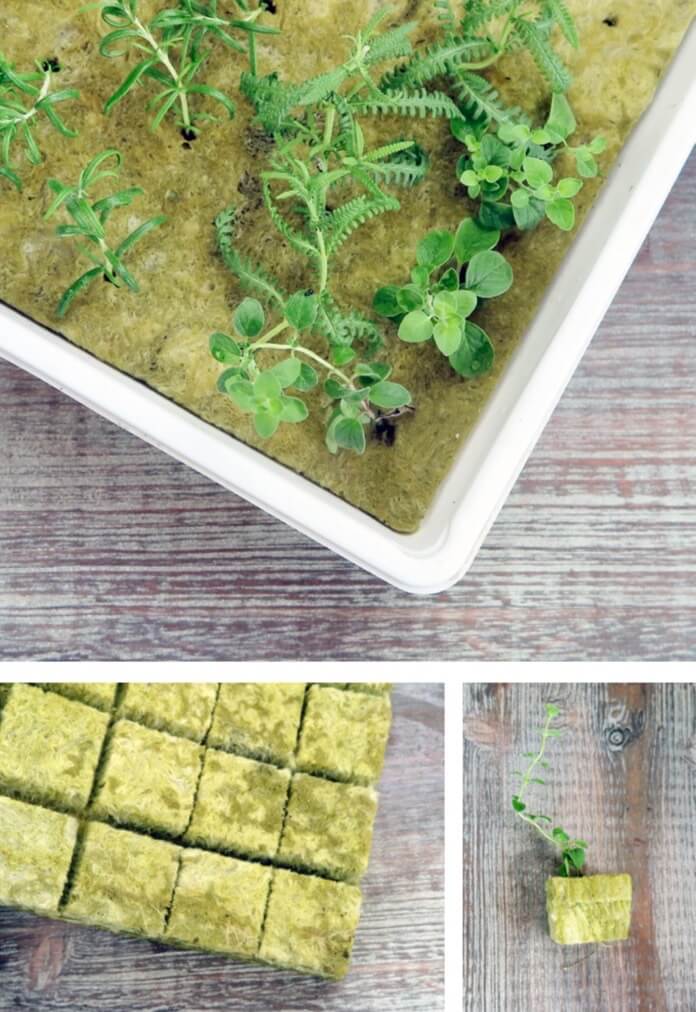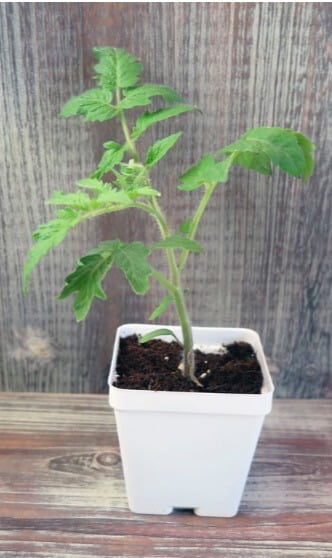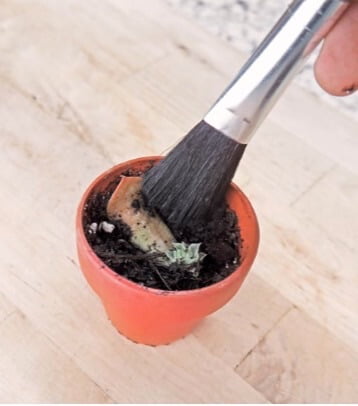Ebook Việt Hoá] Plant parenting: Easy ways to make more houseplants vegetables and flowers - LESLIE F. HALLECK
[Ebook Việt Hoá] Plant parenting – LESLIE F. HALLECK (Nhân giống cây) – HOW TO BUMP UP YOUR PLANTS (Cách để “Thổi” cây giống lên)
- Nguồn: [Ebook Việt Hoá] Plant parenting: Easy ways to make more houseplants, vegetables, and flowers – LESLIE F. HALLECK (Nhân giống cây: Những cách dễ nhất để nhân giống cây cảnh trong nhà, rau và hoa)
- Biên tập: Dũng Cá Xinh (Tháng 08/20201)
- Dịch: Huyền Nguyễn
English
Most often, you’ll do best to choose growing containers with drainage holes in the bottom, or porous fabric grow pots that allow water and air to permeate. Use water-catching trays or tubs to collect the excess water that drains from your pots. Many types of plants will drown if you plant them into a container without a hole. If you are a chronic overwaterer, stay away from containers without drainage holes. You can get away with planting into a solid container if you are growing either plants that love water and won’t mind wet feet, or succulents or cactus plants that you will only water sparingly so that no excess water builds up in the pot.
Fill your new transplant pot with a quality potting soil or custom mix. If you’re transplanting succulents, use a loose potting mix labeled for cacti and succulents. If you’re transplanting veggies and flowers, you can use a general purpose, lightweight potting mix. Avoid using heavy potting mixes meant for shrubs or outdoor containers with small transplants. You can always mix in some coir to help loosen up a soil mix that might be too heavy for young plant starts. Excellent solid fertilizer and soil amendments you can use in your planting mix include worm castings, kelp meal, greensand, lava sand, blood meal, bone meal, fish meal, crushed crab shells, and dry molasses. These amendments will help feed your plants naturally over time.
The next step is to gently transfer your seedling or cutting into the new pot at the same depth at which the seedling naturally emerges. Never pull on a seedling’s stem without first completely loosening it from the sides of the container. Doing so can break the seedling away from its root system. If the seedling has a good root system, you may be able to squeeze both sides of the plug and the seedling will pop right out. If the seed- ling doesn’t have much of a root system, it is probably too early to transplant.
If you’re using a plug tray filled with soil or a soil- less growing media, squeeze the bottom of the plug to loosen the roots away from the inside of the container, then push your finger up against the bottom of the plug (or partially through the drainage hole) to loosen and slide the seedling or cutting up and out of the tray without damaging it. You can also use a knife or spoon. Hold the seedling underneath the root ball to set it into its new container so too much soil doesn’t fall away from the delicate roots.
If you’re growing your seedlings or cuttings in encased seed plugs, Oasis, or rockwool, you won’t have to worry as much about disturbing the root system. With seed plugs you simply lift them out of the tray and place them into the new container. Oasis plugs typically pop right out of their tray cells. And with rockwool sheets, you’ll use a knife to cut out the seed- ling or cutting, then set it in the new container.
Backfill your new container with additional pot- ting mix and lightly press it in and around your new seedling. Fill the soil line to the same level as where your seedling naturally emerged from its original container. Most plants will suffer from potential rotting if you bury them too deep, although some plants such as tomatoes can be planted deeper.
Now that your transplants are actively photosyn- thesizing and growing, they will take up water faster and can dry out quickly under grow lights. Check their water needs more frequently than when the tiny seedlings were safe under a humidity dome.




Tiếng Việt
Thông thường, bạn nên chọn các chậu trồng cây có lỗ thoát nước ở đáy hoặc chậu trồng cây bằng vải xốp cho phép nước và không khí thấm qua. Sử dụng khay hoặc bồn hứng nước để gom lượng nước thừa thoát ra khỏi chậu. Nhiều loại cây sẽ úng nước và chết nếu bạn trồng chúng vào thùng không có lỗ thoát nước. Nếu bạn thường xuyên tưới nước quá nhiều, đừng sử dụng các chậu không có lỗ thoát nước. Bạn có thể trồng cây vào bất cứ loại chậu nào nếu bạn đang trồng những loại cây ưa nước và không gặp nguy hiểm khi bị úng nước, hoặc cây Xương Rồng hoặc cây mọng nước, những loại cây mà bạn chỉ cần tưới ít để không tích tụ nước thừa trong chậu.
Đổ đất bầu chất lượng hoặc hỗn hợp bầu tự trộn vào chậu mới. Nếu bạn đang trồng các loài cây mọng nước, hãy sử dụng hỗn hợp bầu lỏng có dán nhãn dành cho Xương Rồng và các loài cây mọng nước. Nếu bạn đang trồng rau và hoa, bạn có thể sử dụng hỗn hợp bầu nhẹ, dùng chung cho tất cả các loại cây. Tránh sử dụng hỗn hợp bầu nặng dành cho cây bụi hoặc các chậu cây ngoài trời nhỏ. Bạn luôn có thể trộn thêm một ít xơ dừa để giúp làm tơi xốp hỗn hợp đất quá nặng đối với sự khởi đầu của cây non. Phân bón rắn tuyệt vời và các chất cải tạo đất mà bạn có thể sử dụng trong hỗn hợp trồng trọt của mình bao gồm bột trùn quế, bột tảo bẹ, rau xanh, cát nham thạch, bột máu, bột xương, bột cá, vỏ cua nghiền và mật mía khô. Những chất cải tạo đất này sẽ giúp nuôi cây một cách tự nhiên theo thời gian.
Bước tiếp theo là nhẹ nhàng chuyển cây con hoặc càng giâm sang chậu mới ở cùng độ sâu mà cây con mọc lên. Không bao giờ kéo thân cây con mà không nới lỏng hoàn toàn khỏi các cạnh bên của chậu. Làm như vậy có thể phá vỡ hệ thống rễ của cây con. Nếu cây con có bộ rễ tốt, bạn có thể bóp cả hai mặt của ô gieo hạt và cây con sẽ bật ra ngay. Nếu cây con chưa có nhiều rễ, có lẽ còn quá sớm để cấy ghép.
Nếu bạn đang sử dụng khay gieo hạt chứa đầy đất hoặc chất trồng ít đất, hãy bóp phần đáy của ô gieo hạt để nới lỏng rễ khỏi các cạnh bên, sau đó ấn ngón tay lên phía dưới đáy ô gieo (hoặc qua lỗ thoát nước) để nới lỏng và trượt cây con hoặc cành giâm lên và lấy ra khỏi khay mà không làm hỏng cây. Bạn cũng có thể dùng dao hoặc thìa. Giữ cây con bên dưới bóng rễ để đặt nó vào thùng mới và tránh quá nhiều đất rơi khỏi rễ.
Nếu bạn đang trồng cây con hoặc cành giâm trong ô gieo hạt bọc, Oasis hoặc rockwool, bạn sẽ không phải lo lắng nhiều về việc làm xáo trộn hệ thống rễ. Với ô gieo hạt giống, bạn chỉ cần nhấc ra khỏi khay và đặt chúng vào chậu mới. Các ô gieo hạt giống Oasis thường bật ra khỏi các ô khay, với những ô gieo hạt giống vải len sợi, bạn sẽ dùng dao để cắt bỏ, sau đó đặt cây con hoặc cành giâm vào chậu mới.
Đổ hỗn hợp bầu bổ sung vào chậu mới và ấn nhẹ xung quanh cây con. Lấp đất đến cùng mức đất mà cây con trồi lên một cách tự nhiên từ chậu ban đầu. Hầu hết các loại cây sẽ bị thối rữa tiềm ẩn nếu bạn trồng quá sâu, mặc dù một số cây như Cà Chua (tomato) có thể được trồng sâu hơn.
Giờ đây, cây của bạn đang tích cực hình thành và phát triển, chúng sẽ hấp thụ nước nhanh hơn và có thể khô nhanh dưới ánh sáng của đèn trồng. Kiểm tra nhu cầu nước của cây thường xuyên hơn so với khi những cây nhỏ được trồng dưới mái vòm ẩm ướt.




![[Ebook Việt Hoá] Plant parenting – LESLIE F. HALLECK (Nhân giống cây) – HOW TO BUMP UP YOUR PLANTS (Cách để “Thổi” cây giống lên) [Ebook Việt Hoá] Plant parenting – LESLIE F. HALLECK (Nhân giống cây) – HOW TO BUMP UP YOUR PLANTS (Cách để “Thổi” cây giống lên)](https://vn1.vdrive.vn/codai.net/2021/02/ebook-huong-dan-nhan-giong-cay-canh-rau-va-hoa-08.jpg)


